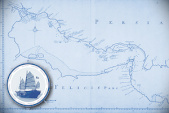II.5 Persia, the Arabian Peninsula, Madagascar, Mauritius

The trading connections with Persia also benefitted Java and Batavia. Persia was an important market for the sugar produced in the mills operating in the Batavian Environs (Ommelanden) and on the northeast coast of Java. Southeast Asian rulers and kings were also interested in maintaining ties with the Persian Gulf as they shared an important hobby: collecting Persian horses. Dried raisins and dates and other luxury products were popular items of consumption at the courts.
After the fall of the Safavid dynasty in 1722 following an Afghan invasion, the import of sugar and spices from the Nusantara, and the export of Iranian silk and gold species fell off sharply. Although the Gentlemen 17 (the Board of VOC Governors) in the Dutch Republic decided to close down all trading facilities in the Persian Gulf, Governor-General Jacob Mossel (1750-1761) challenged this decison and decided to build Fort Mosselstein on the island of Kharq in 1753. A number of sugar ships from Batavia reached Kharq via Masqat, and trade with Java was continued until Mosselstein fell into the hands of a local ruler in 1766 when the whole experiment collapsed. The loss of the sugar ship the Amstelveen on the coast of Oman in 1763 only hastened the decision to leave the Gulf. A decade later, private Dutch traders resumed the sales of sugar and spices, in particular in Masqat.




